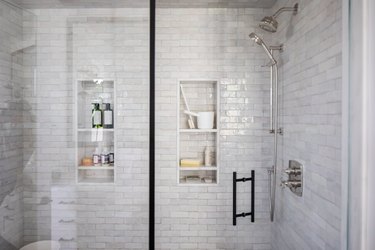Cement board has pretty much replaced the mortar bed as a backing for floor tile, and in wet areas, like bathrooms, it's the preferred backing material for wall tiles. Durock, WonderBoard, and James Hardie are some of the better-known brands, and when you're hanging a product like Hardie board, "Which side out?" is one of the questions you'll have to ask.
The answer is that it depends on what you're using to stick down the tiles. Cement board has a smooth face and a rough one, and the rough face should be facing out if you're using mortar or thinset to adhere the tiles. Tile mastic, on the other hand, sticks better to a smooth surface, so the smooth side should be facing out if that's what you're using to adhere the tiles. If you've already completed the job and are thinking you might have done it wrong, don't worry because it doesn't matter very much.
Video of the Day
Video of the Day
Tip
As a general guideline, the rough side of the cement board should be up when using thinset or mortar, and the smooth side should be up when using tile mastic.
Which Is the Rough Side?
Cement board and fiber cement board are two different products, and if you're using the latter, you see cellulose or fiberglass fibers enmeshed in the filler material, most of which is Portland cement. This mesh is more pronounced on one side than the other, and the side with the more pronounced mesh pattern is the rough side.
If you're using cement board, there won't be any fibers to help you distinguish the sides, but it's still fairly easy to tell them apart. The smooth side looks like it has been smoothed to a glossy finish with a hand trowel, while the rough side appears unfinished.
Because the rough side has more fissures, it bonds better with mortar and thinset, which are both somewhat granular. The smooth side, on the other hand, is better suited for holding a gummy, flexible material, like tile mastic.
Cutting and Installing Cement Board
You install cement board on walls in much the same way that you install drywall, and you installing it on floors in a way similar to installing plywood subfloors. You should always leave a 1/4-inch gap around the periphery of the installation to allow for expansion, and you should leave an 1/8-inch gap between sheets for the same reason.
You can cut cement board with a saw, but it dulls blades quickly, so you're probably better off using a carbide abrasive blade in the saw. The process raises lots of dust, so be sure to wear goggles and a dust mask. You can also cut sheets by scoring with a utility knife and breaking, but this is hard on knife blades.
You should use special screws when you screw cement board sheets to the studs or subflooring. Cement board screws are corrosion-resistant and have wide, flat heads that sink flush with the surface of the board. They typically have Torx heads, which resist stripping when you bear down with the force needed to sink the screws.
Finishing the Surface for Tile
Whether you use thinset or mastic to adhere the tiles, you must first close the gaps between boards to ensure a waterproof surface, and you do this in much the same way as you finish drywall joints. Instead of drywall mud and paper tape, though, you use mortar or thinset and fiberglass tape.
After all the boards have been screwed down, apply a coat of mortar or thinset to each joint and lay a length of fiberglass tape in the wet material. Scrape the joint as flat as possible with a trowel; you don't want any bulges underneath your tiles. After the material has dried, some tile pros like to add a second coat of mortar or thinset to make sure the joints are sealed. This is a good idea when you are tiling a shower stall or a similarly wet environment.
